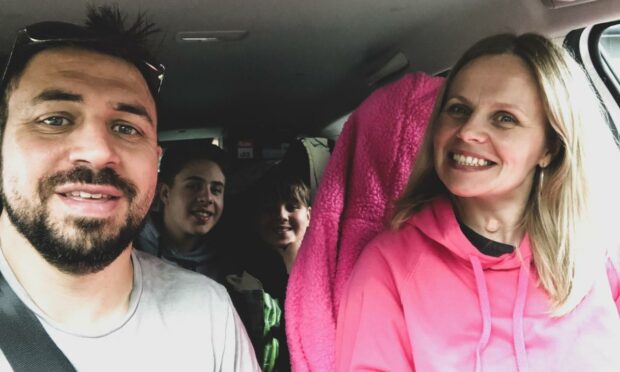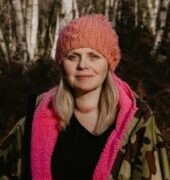If you get cancer in a pandemic – did it really happen?
A lot of things have been given to us throughout these last 18 months. We’ve had new protections through vaccines, new ways of working, new pressures and strains, new ways of communicating, even.
But for all of that, something powerful was also removed: bearing witness to life’s big moments.
Last year I visited my doctor, worried the lump in my neck and pain when I swallowed was more than just swollen glands or a bad throat. I wasn’t a candidate for sinister things, he reassured me, but would refer me – with the caveat: “But we are in a pandemic, remember.”
Covid meant I was triaged to a non-urgent room with a non-modern scanner, and, as a consequence, a non-specific result.
The day of my summer holiday – in that brief window when we could Eat Out to Help Out – I had to nip to the hospital en route to the Hebrides for what would be the first of many biopsies.
First one: “All looks good but let’s do it again.”
Second result: “Findings don’t match the picture – let’s do it again.”
Third report: “Ah… actually… this is concerning. Something’s not right in your lymph nodes as well.”
Finally, at 8pm one evening last November, a surgeon I’d only ever spoken to over the phone called me at home.
“We think this could be cancer.”
Forced to carry on alone because of the pandemic
A week later I was dropped off outside the hospital. I walked alone, in a mask, to the ward where I sat on my own before going into theatre.
The original plan was to go “in” see what was going in, do a very specific biopsy and, if necessary, take out half of my thyroid.
When I woke up my doctor – whose whole face I have yet to see – was sitting at the bottom of my bed to tell me that I’d had a radical neck dissection. It was a much longer surgery than planned but my lymph nodes were gone, a neck drain was in, and the right side of my thyroid was no more.
“Necrotic tissue” is never a good thing.
Within days it was confirmed I had stage one papillary thyroid cancer that had spread to my lymph nodes.
A week after that, I was alone again outside the hospital, walking back to the ward to have a second operation to rid my neck of the rest of my thyroid and any more diseased lymph nodes.
This time it was simple. Twenty hours after surgery I was shuffling on my own down a corridor, carrying a bag of pills with a rucksack trying not to strain my newly reopened neck.
Surrounded by signs that said things like “oncology” and “nuclear medicine” I was entirely without support, laminated Covid-19 posters reminding me why.
I desperately needed my people
There was no hand-holding to get a diagnosis. No husband waiting on the chair in my cubicle when I returned from theatre. I had no one to lift my bag or open a door.
But more crucially, for my entire recovery – although surrounded by my immediate family – I had no friends to just see me in all my sobbing-one-minute, strong-the-next, glory.
I’ve become convinced that there is something about being able to bear witness to events and experiences – in a tactile, fully present way – that is so absolutely fundamental to how we process life
I’ve been through stuff in the past. I’ve had operations. I’ve had babies. I’ve lost babies. I’ve plummeted into grief. But all of it was done in community. And I’m convinced there’s something about being Scottish that needs that.
Tell me everything doesn’t get a tiny bit better with an in-the-room or over-the-fence “aw, hen” or “aw, son” accompanied by a furrowed brow.
I also needed my church friends to come in and smother me with praying hands. I needed my husband’s mates to burn stuff with him in the garden. I needed my people – and their kids – to get around me and my kids with food, and sitcom marathons, and unnecessary cushion tweaking.
But we had none of it.
A life-altering experience felt like a dream
Eight weeks later, despite still having a house full of flowers and a scar that makes my Weegie accent even more threatening, I was back at work. In an office. Like nothing had happened.
This life-altering thing took place, and but for my incessant oversharing on Instagram and pain that still won’t shift, it was like I had dreamt it.
And so I’ve become convinced that there is something about being able to bear witness to events and experiences – in a tactile, fully present way – that is so absolutely fundamental to how we process life; how we understand it and how we recover from it when we’re dealt a duff hand.
I know I’m not alone in feeling like this.
I think of all the new parents with no visitors or help in those newborn days. Or the grandparents kept at a distance. Or the people walking the aisle to a handful of distanced faces. Or those watching from behind a lens. Or those grieving lost loved ones, without a celebration worthy of their lives. Or those like me who were unseen in their treatment (or inability to get treatment).
While it was all necessary – absolutely necessary – it’s changed us.
At our core we need one another
In January I had to return to hospital for radiation treatment. I stayed for four days in a lead-lined room away from other humans. The leaflet, designed way before any global pandemic, spoke of how hard it may be to be isolated, to go through radiation on your own. It said counselling could be made available, even.
It made me smile.
My cancer, of all the cancer journeys out there, is a pretty good one. But even so, leaflets like that just confirm to me that at our core we know we need one another. Even if it is just to be together, to see one another, through the stuff we can’t do anything about.
- Check your neck! For more information on Thyroid Cancer visit the Butterfly Thyroid Cancer Trust or the British Thyroid Foundation
Lindsay Bruce is a journalist, author and speaker



